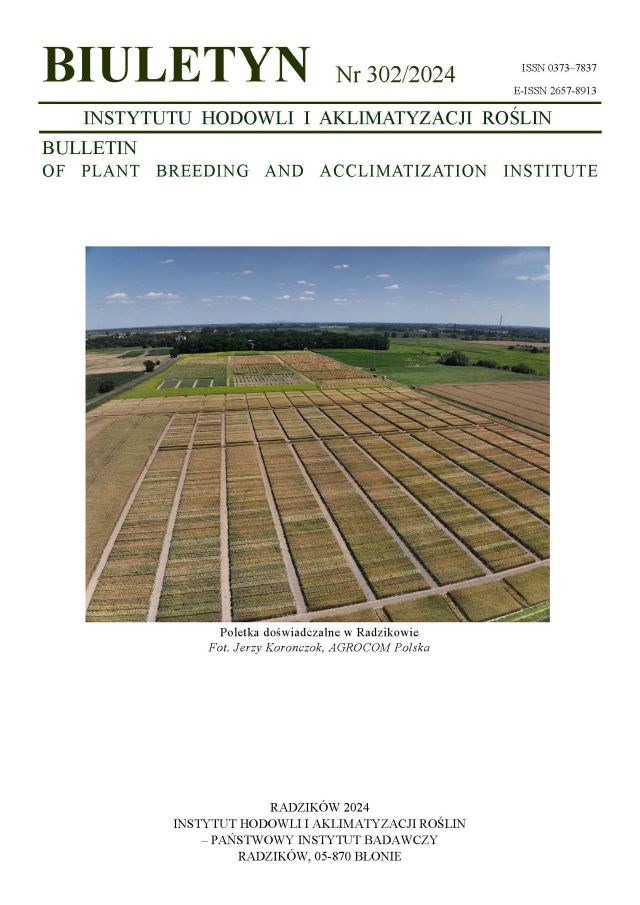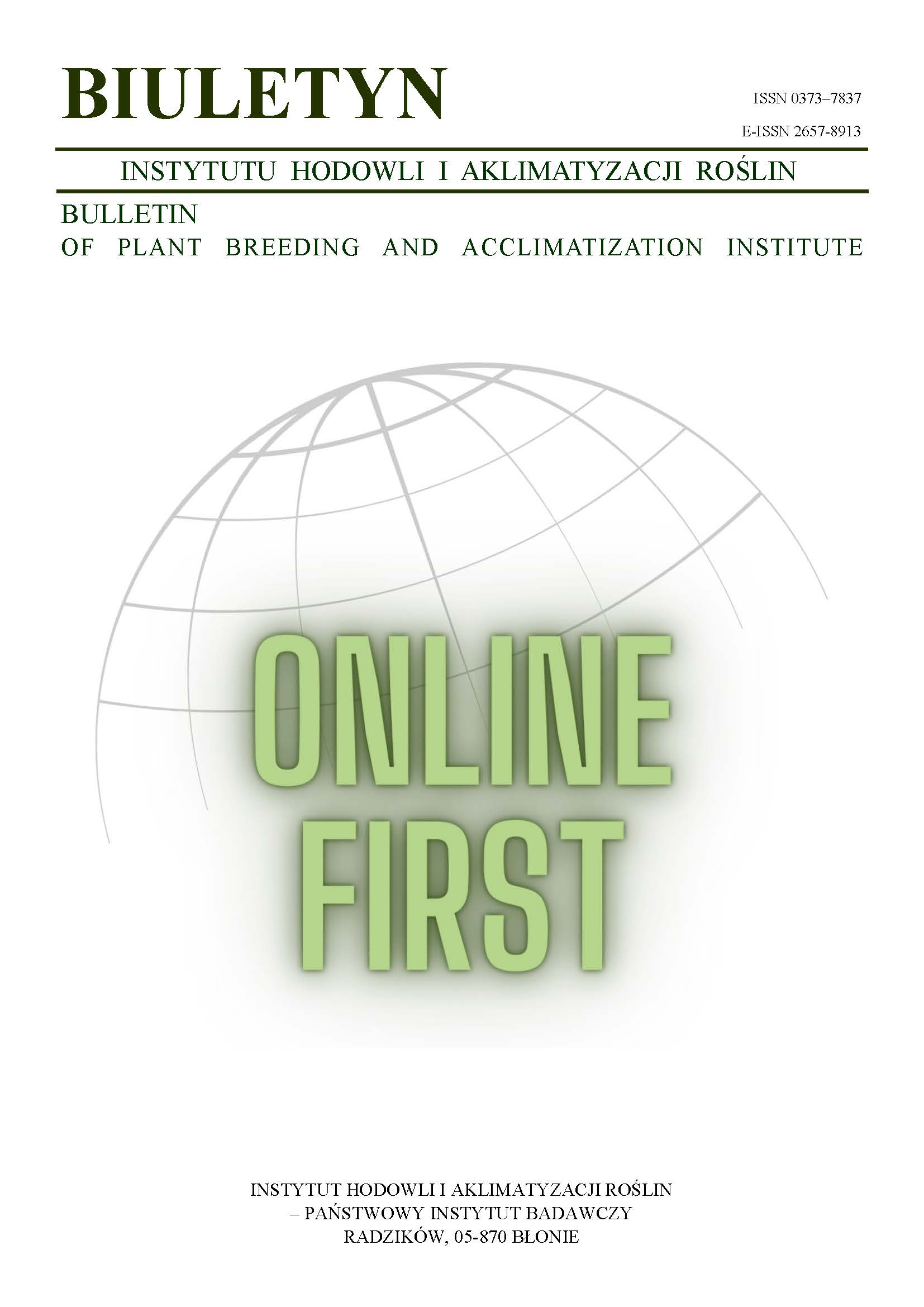Preliminary attempts to use a viscosity assay as a simple criterion for selecting malting and feed barley towards quality traits
Katarzyna Kasztelowicz
k.kasztelowicz@ihar.edu.plPracownia Oceny Jakości Produktów Roślinnych, Zakład Biochemii i Fizjologii Roślin, Instytut Hodowli i Aklimatyzacji Roślin, Radzików (Poland)
Danuta Boros
Pracownia Oceny Jakości Produktów Roślinnych, Zakład Biochemii i Fizjologii Roślin, Instytut Hodowli i Aklimatyzacji Roślin, Radzików (Poland)
Abstract
The aim of the study was to determine new extraction conditions to be applied in the assay of grain extract viscosity, which would reflect similarity and complexity of traits determining the malting and feeding values of barley. The methodological studies were initiated by selection of seven testing varieties of variable malting quality, then establishing a most appropriate kind of solvent and its degree of dilution in relation to the grain. The varieties, all originating from the same environmental conditions, were evaluated for malting and feeding values. In a feeding trial broiler chickens, known to be very susceptible to the viscous components of the diet, were used. The results showed that varieties Rudzik, Binal and Blask, which characterised with the highest malting and feeding values, had also the lowest extract viscosity, regardless of a solvent used, and the lowest content of soluble nonstarch polysaccharides. Preliminary results indicate that the assay of extract viscosity can be a handy tool in selection of barley for high brewing and feeding values. Further studies, involving larger testing material, have been planned.
Keywords:
barley, qualitative selection, extract viscosity, malting quality, feeding valueReferences
Aastrup S. 1979. The relationship between the viscosity of an acid flour extract of barley and its ß-glucan content. Carlsberg Res. Commun. 44: 289 — 304.
DOI: https://doi.org/10.1007/BF02906492
Google Scholar
Bamforth C. W. 1994. ß-glucan and ß-glucanases in malting and brewing: practical aspects. Brewers Digest. 5: 12 — 17.
Google Scholar
Bhatty R. S. 1987. Relationship between acid extract viscosity and total soluble and insoluble ß-glucan contents of hulled and hulless barley. Can. J. Plant Sci. 67: 997 — 1008.
DOI: https://doi.org/10.4141/cjps87-136
Google Scholar
Boros D., Madej L., Jagodzinski J. 1997. Perspectives of selection for better nutritive quality of rye I. Viscosity of grain water extract as an index of nutritive value of rye for broiler chicks. Plant Breed. Seed Sci. 41: 81 — 89.
Google Scholar
Campbell G. L., Rossnagel B. G., Classen H. L., Thacker P. A. 1989. Genotypic and environmental differences in extract viscosity of barley and their relationship to its nutritive value for broiler chickens. Anim. Feed Sci. Technol. 26: 221 — 230.
DOI: https://doi.org/10.1016/0377-8401(89)90036-9
Google Scholar
Cyran M., Izydorczyk M. S., MacGregor A. W. 2002. Structural characteristics of water-extractable nonstarch polysaccharides from barley malt. Cereal Chem. 79: 359 — 366.
DOI: https://doi.org/10.1094/CCHEM.2002.79.3.359
Google Scholar
Debyser W., Derdelinckx G., Delcour J. A. 1997. Arabinoxylan and arabinoxylan hydrolysing activities in barley malts and warts derived from them. J. Cereal Sci. 26: 67 — 74.
DOI: https://doi.org/10.1006/jcrs.1996.0107
Google Scholar
Englyst H. N., Cummings J. H. 1984. Simplified method for the measurement of total non-starch polysaccharides by gas-liquid chromatography of constituent sugars as alditol acetates. Analyst 109: 937 — 942.
DOI: https://doi.org/10.1039/an9840900937
Google Scholar
Greenberg D. C., Whitmore E. T. 1974. A rapid method for estimating the viscosity of barley extracts. J. Inst. Brew. 80: 31 — 33.
DOI: https://doi.org/10.1002/j.2050-0416.1974.tb03579.x
Google Scholar
Han J. Y., Schwarz P. B. 1996. Arabinoxylan composition in barley, malt and beer. J. Am. Soc. Brew. Chem. 54: 216 — 220.
DOI: https://doi.org/10.1094/ASBCJ-54-0216
Google Scholar
Izydorczyk M. S., MacGregor A. W. 2000. Evidence of intermolecular interactions of -glucans and arabinoxylans. Carbohydr. Polym. 41: 417 — 420.
DOI: https://doi.org/10.1016/S0144-8617(99)00151-4
Google Scholar
Jadhav S. J., Lutz S. E., Ghorpade V. M., Salunkhe D. K. 1998. Barley: Chemistry and value added processing. Crit. Rev. Food Sci. 38: 123 — 171.
DOI: https://doi.org/10.1080/10408699891274183
Google Scholar
Koreleski J. 1993. Wartość jęczmienia oplewionego i nie oplewionego w żywieniu kurcząt oraz skuteczność dodatku enzymów. Rocz. Nauk Zootech. 20: 207 — 224.
Google Scholar
MacGregor A. W., Fincher G. B. 1993. Carbohydrates of the barley grain. In: Barley: chemistry and technology (ed. MacGregor i Batty). Am. Ass. Cereal Chem. St. Paul. MN: 73 — 110.
Google Scholar
McCleary B. V., Glennie-Holmes M. 1985. Enzymatic quantification of (13. 14)--D-glucan in barley and malt. J. Inst. Brew. 91: 285 — 295.
DOI: https://doi.org/10.1002/j.2050-0416.1985.tb04345.x
Google Scholar
Mollina-Cano J. L. 1991. Breeding barley for malting and feeding quality. Ciheam Options Mediterraneennees. 20: 34 — 44.
Google Scholar
Molina-Cano J. M., Francesch M., Perez-Vendrell A. M., Ramo T., Voltas J., Brufau. J. 1997. Genetic and environmental variation in malting and feed quality of barley. J. Cereal Sci. 25: 37 — 47.
DOI: https://doi.org/10.1006/jcrs.1996.0067
Google Scholar
Morgan A. H., Gothard P. G. 1977. A rapid simple viscometric technique for indirect estimation of soluble ß-glucan content of raw barley. J. Inst. Brew. Vol. 83: 37 — 38.
DOI: https://doi.org/10.1002/j.2050-0416.1975.tb03790.x
Google Scholar
Munck L. 1991. Advances in barley quality. Experiences and perspectives. Ciheam Options Mediterraneennees. 20: 9 — 18.
Google Scholar
Rutkowski A. 1996. Wartość pokarmowa zbóż dla kurcząt brojlerów. Rocz. AR Poznań. Rozprawy naukowe z. 267.
Google Scholar
Smith D. B., Morgan A. G., Aastrup S. 1980. Variation in the biochemical composition of acid extract from barleys of contrasting malting quality. J. Inst. Brew. 86: 113 — 119.
DOI: https://doi.org/10.1002/j.2050-0416.1980.tb06881.x
Google Scholar
Ullrich S. E., Clancy J. A., Cuti J. G., Tompkins C. M. 1991. Analysis of beta-glucans in barley and malt: A comparison of four methods. Amer. Soc. Brew. Chem. J. 49: 110 — 115.
DOI: https://doi.org/10.1094/ASBCJ-49-0110
Google Scholar
Authors
Katarzyna Kasztelowiczk.kasztelowicz@ihar.edu.pl
Pracownia Oceny Jakości Produktów Roślinnych, Zakład Biochemii i Fizjologii Roślin, Instytut Hodowli i Aklimatyzacji Roślin, Radzików Poland
Authors
Danuta BorosPracownia Oceny Jakości Produktów Roślinnych, Zakład Biochemii i Fizjologii Roślin, Instytut Hodowli i Aklimatyzacji Roślin, Radzików Poland
Statistics
Abstract views: 104PDF downloads: 24
License
Copyright (c) 2005 Katarzyna Kasztelowicz, Danuta Boros

This work is licensed under a Creative Commons Attribution-ShareAlike 4.0 International License.
Upon submitting the article, the Authors grant the Publisher a non-exclusive and free license to use the article for an indefinite period of time throughout the world in the following fields of use:
- Production and reproduction of copies of the article using a specific technique, including printing and digital technology.
- Placing on the market, lending or renting the original or copies of the article.
- Public performance, exhibition, display, reproduction, broadcasting and re-broadcasting, as well as making the article publicly available in such a way that everyone can access it at a place and time of their choice.
- Including the article in a collective work.
- Uploading an article in electronic form to electronic platforms or otherwise introducing an article in electronic form to the Internet or other network.
- Dissemination of the article in electronic form on the Internet or other network, in collective work as well as independently.
- Making the article available in an electronic version in such a way that everyone can access it at a place and time of their choice, in particular via the Internet.
Authors by sending a request for publication:
- They consent to the publication of the article in the journal,
- They agree to give the publication a DOI (Digital Object Identifier),
- They undertake to comply with the publishing house's code of ethics in accordance with the guidelines of the Committee on Publication Ethics (COPE), (http://ihar.edu.pl/biblioteka_i_wydawnictwa.php),
- They consent to the articles being made available in electronic form under the CC BY-SA 4.0 license, in open access,
- They agree to send article metadata to commercial and non-commercial journal indexing databases.
Most read articles by the same author(s)
- Danuta Boros, Damian Gołębiewski, Components determining the nutritive and functional values of oat and its relation between hulled and dehulled grains , Bulletin of Plant Breeding and Acclimatization Institute: No. 286 (2019): Special issue
- Magdalena Wiśniewska, Danuta Boros, Józef Zych, Nutritional value of selected mixtures of spring cereals with legumes , Bulletin of Plant Breeding and Acclimatization Institute: No. 289 (2020): Regular issue
- Damian Gołębiewski , Danuta Boros, Kinga Gołębiewska, Anna Fraś , Nutritive and bioactive potential of oat cultivars , Bulletin of Plant Breeding and Acclimatization Institute: No. 287 (2019): Special issue
- Lech Boros, Anna Wawer, Magdalena Wiśniewska, Danuta Boros, Effect of genotype and contrasting climate conditions on physical and chemical characteristics of soybean (Glycine max L. Merrill) , Bulletin of Plant Breeding and Acclimatization Institute: No. 296 (2021): Regular issue
- Danuta Boros, Alkylresorcinols of cereal grains — their importance in food and feed , Bulletin of Plant Breeding and Acclimatization Institute: No. 277 (2015): Regular issue
- Kinga Myszka, Beata Kamińska, Anna Fraś, Magdalena Ploch, Danuta Boros, Dumas method as an alternative approach for determining protein contents of plant products — comparative study with Kjeldahl method , Bulletin of Plant Breeding and Acclimatization Institute: No. 260/261 (2011): Regular issue
- Danuta Boros, Magdalena Wiśniewska, Marlena Gzowska, Józef Zych, Edward Gacek, Improvement of the spring wheat nutritional value by sowing variety mixtures , Bulletin of Plant Breeding and Acclimatization Institute: No. 289 (2020): Regular issue
- Danuta Boros, Kinga Gołębiewska, Components determining the low protein digestibility of meal obtained from seeds of winter rapeseed , Bulletin of Plant Breeding and Acclimatization Institute: No. 286 (2019): Special issue
- Damian Gołębiewski, Kinga Myszka, Anna Fraś, Danuta Boros, Janusz Burek, Dariusz R. Mańkowski, Evaluation of genetic and environmental variability of traits that determine malting quality of spring barley lines from preliminary trials in 2012 , Bulletin of Plant Breeding and Acclimatization Institute: No. 268 (2013): Regular issue
- Anna Fraś, Danuta Boros, Influence of environmental conditions on the variability of dietary fibre content in winter wheat grain , Bulletin of Plant Breeding and Acclimatization Institute: No. 277 (2015): Regular issue














